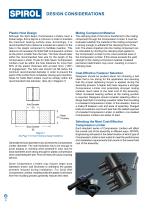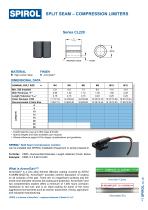 Website:
SPIROL
Website:
SPIROL
Catalog excerpts

THE FUNCTION OF A COMPRESSION LIMITER The primary function of a Compression Limiter is to provide and maintain joint integrity of a plastic assembly. Compression Limiters are designed to protect the plastic components of an assembly from the compressive loads generated by the tightening of bolts, thereby assuring continued integrity of the bolted connection. In practice, the Compression Limiter should be slightly shorter than the thickness of the plastic host. As the bolt is tightened the plastic compresses and the stress in the plastic increases until the head of the bolt, or washer if one...
Open the catalog to page 2
SPIROL’S COMPRESSION LIMITERS SPIROL offers a range of both formed and machined Compression Limiters including split seam, moulded in, oval and solid wall designs. All formed Compression Limiters, except the Series CL220, are zinc plated and have a supplementary coating of trivalent passivation and an organic sealant for corrosion resistance. This finish provides 144 hours to white corrosion, and 384 hours to red corrosion when salt spray tested in accordance with ASTM B117. SPIROL’s Series CL220 Compression Limiters are coated with ArmorGalv®, a zinc alloy thermal diffusion coating...
Open the catalog to page 3
COMPRESSION LIMITERS • Series CL460 Moulded-In - Oval: The CL460 Series is similar to the oval Series CL400, but produced with a butted-seam so as to prevent plastic from entering the inner diameter during the moulding process, and a radial groove to ensure positive retention within the hole. This series also accommodates 2.25mm extra clearance on one axis. The CL460 is rated for use up to ISO Class 8.8 bolts. • Series CL500 Moulded-In: The Series CL500 is produced from low carbon steel with a butted seam to prevent plastic from entering the inner diameter of the Compression Limiter during...
Open the catalog to page 4
STANDARD OFFERING BREAKDOWN & MATERIALS SERIES Other diameters available upon request. Install one or multiple Compression Limiters simultaneously into various polymers, thermoplastics and/or thermosets. Options such as vision sensing for part presence, automatic fixture identification, customised rotary or linear fixture motion, password protection of HMI screens, keyed reset, status/indicator lights, audible fault alarm, and part marking can be added for enhanced productivity, heightened process control and error-proofing. Model CL Semi-Automatic Multi-Tip Highly flexible platen-style...
Open the catalog to page 5
DESIGN CONSIDERATIONS Recommended Loading The integrity of a bolted joint requires that all of the components in the load path be capable of sustaining for indefinite periods, under all environmental conditions, the fastening load initially applied. To do this, all components must be designed for a specific stress, and the fastener being used must be tightened to an appropriate level so as not to exceed the yield point (elastic limit) of any of the components. The reason that metal Compression Limiters are required is because plastic always exhibits stress and strain relaxation under even...
Open the catalog to page 6
BOLT SPECIFICATIONS Typical tightening torque values to achieve recommended Clamping Loads are based on the following formula: Where: D = nominal bolt diameter K = torque-friction coefficient P = bolt clamping load COMMON METRIC BOLTS PER ISO 898 STANDARD FASTENER RATING: STRESS UNDER PROOF LOAD Notes: * Inch sizes are not directly covered by SAE J429, but are calculated appropriately. • Calculations are based on using bolt proof loads per SAE J429 and ISO 898 respectively. • Clamp load in calculation is based on approximately 75% of the proof load for each bolt. SPIROL strongly recommends...
Open the catalog to page 7
DESIGN CONSIDERATIONS Plastic Host Design Mating Component Material Although the Split Seam Compression Limiters have a broken edge, this is kept to a minimum in order to maintain the maximum bearing surface area. Accordingly, it is recommended that a radius be moulded as a lead-in to the hole in the plastic component to facilitate insertion. This radius is not necessary for Solid Wall Compression Limiters as the pilot is smaller than the hole. The hole should taper within the recommended hole size for the length of the Compression Limiter. Hosts for Split Seam Compression Limiters must be...
Open the catalog to page 8
DESIGN GUIDELINES SPIROL Allowable Compression of the Plastic Component For most commonly used moulded plastics, it is difficult to determine a specific maximum amount that they can be compressed in a short period of time. There are too many variables involved to make a specific calculation. Such features as the specific plastic, filler, mould design, wall thickness, and stress concentrations all impact the durability of the plastic. As a general guideline, 3%-5% compression of thermoplastic materials is reasonable. Over a short period of time the plastic will usually exhibit stress...
Open the catalog to page 9
DESIGN GUIDELINES Ideal Bolted Joint Bolt is tightened to 75% of its proof load. Bolt head applies a clamp load on the plastic and bottoms out on the Limiter. Limiter is compressed between bolt’s head and mating component. Host thickness is greater than or equal to the length of the Limiter, and able to absorb the clamp load. Correct hole size ensures retention of the Limiter. The mating component can withstand compression force generated by bolt. The installed Limiter is aligned with the Insert (when used) to prevent a jack-out condition. The following design guidelines should be...
Open the catalog to page 10
SPLIT SEAM - COMPRESSION LIMITERSSeries CL220 DIMENSIONAL DATA MATERIAL FINISH B High Carbon Steel H ArmorGalv® • CL220 rated for use up to ISO Class 8.8 bolts. • Special lengths and sizes available upon request. • Please reference pages 6-8 for design considerations and guidelines. SPIROL® Split Seam Compression Limiters can be installed with SPIROL Installation Equipment or simply pressed in. To Order: CMPL, Nominal Bolt Diameter, Length, Material, Finish, Series Example: CMPL 6 X 6 BH CL220 What is ArmorGalv®? ArmorGalv® is a zinc alloy thermal diffusion coating covered by ASTM...
Open the catalog to page 11All SPIROL catalogs and technical brochures
-
Alignment Dowels/Bushings
12 Pages
-
Slotted Spring Pins
16 Pages
-
Latch Pins for Plastics
2 Pages
-
Railroad Nuts - AAR Series
2 Pages
-
SPIROL Corporate Brochure
12 Pages
-
Disc Springs
20 Pages
-
Coiled Spring Pins
24 Pages
-
Series RH600 Twist-Lok™ Pins
2 Pages
-
Cosmestic Pins 550 series
2 Pages
-
Installation Technology
8 Pages
-
SPIROL Precision Shims
8 Pages
-
Medical Device Applications
2 Pages
-
SPIROL Solid Pins Catalog
12 Pages
-
Series 2000 Series 2000
4 Pages
-
Aerospace Applications Flyer
2 Pages
-
PH series PH series
2 Pages
-
HC series HC series
2 Pages
-
Tables Standard
2 Pages
-
Tables Lift and Roll
2 Pages
-
SPD, CXA, CXD, CXE CRD
2 Pages
-
880 Series
2 Pages
































































